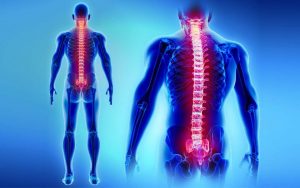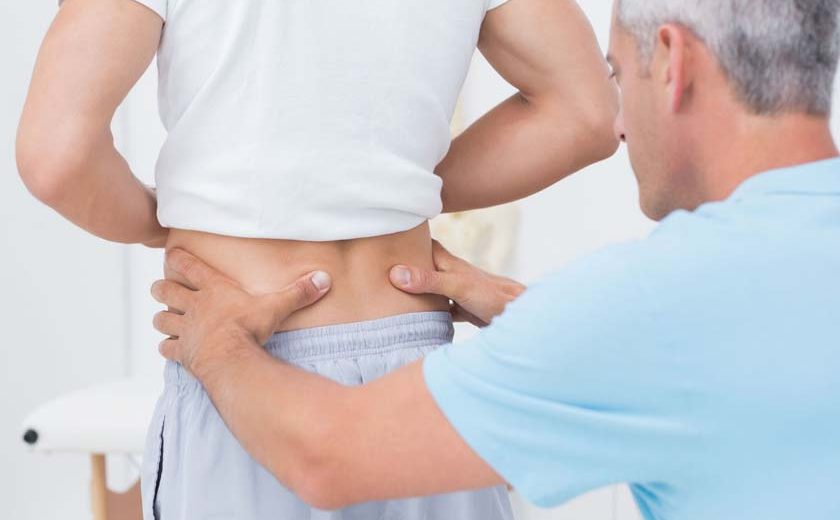Ever since we started standing on two feet and walking upright, be it from toddler to adulthood or from evolutionary sense, man has been plagued with backache.
Backache affects 90 percent of people at least once in their lifetime. The spine and the feet form an integral part of weight bearing system that extends from head to toe, our ‘pillar and foundation’ so to speak. It is only befitting to assume that the conditions of the spine and the feet affect one another for the better or worse.
The spine in human essentially has surpassed its role in the four-legged, as a bridge between the front limbs and hind limbs and to protect the spinal cord alone. It is the essentially the main structure that supports us and helps to keep us up erect. The spine is formed by 33 vertebral bone stacked one on top of the other separated and kept apart by the cushiony inter-vertebral disc in its front portion, yet flexibly latched on one another by the facets joints on its rear ends.
The spine is quite straight if we look at it from the front. However, when you look at it from sideways, the backward curve at the chest- known as kyphosis is balanced at both its upper end and lower end – at the neck and lower back – by a forward curve known as lordosis. This balance is further perfected by allowing movement at the neck and lower back, to rotate and to bend, bringing the spine to a perfect alignment. This enables us to stand and function with minimal effort and strength.
This balance can be upset by many reasons. The most common at this day and age is the posture we tend to use while sitting and working. Inarguably, one of the main ergonomic drawbacks of the laptop is that the screen and keyboard are very close together. The usage of laptops being the case or bending forward for hours of reading and writing, we tend to assume slouching posture for long periods. This results in tiring of the back muscles and over time, causes wear and tear may be enough to damage the inter-vertebral disc. If we let this process continue, these discs may extrude out and exert pressure on the nearby nerves, the very nerves it is designed to protect.
The instability caused by the damaged discs will later cause permanent damage to the facet joints- usually by the middle age- and this is known as spondylosis. Sometimes one vertebra may slide on top of another known as spondylolisthesis. Trauma can be the cause of this slide. Injury can also cause fractures when the insult is severe enough or if the bone is too weak as in osteoporosis, seen in elderly. Spine instability or pressure on the nerves may rarely also be caused by infection or tumors.
These insults to the spine and the resultant effect of nerve being compressed at the spine may affect the legs and feet in a number of ways. Shooting pain to the feet can arise when the compressed nerve root at the spine is being irritated or stretched. If the insult is in the lower back, this will be particularly obvious when we try to walk on our heels. This pain can also be seen when we try to bend forward while keeping the knee straight. The medical term for this is sciatica.
Nerves are essentially the ‘electrical cables’ that send messages to allow movement by the muscles and in return receives message conveying feeling of pain and touch among others, back to the brain. These functions once interrupted by pressure on the nerve root near the spine area, will result in weakness and numbness in very clearly defined areas. The L5 and the S1 nerve roots are the most common ones to get compressed when the lower back is affected. The irritation of these nerves will show their tantrum at the area where they supply, the ankle and the feet. Depending on the extent of the irritation, they may surface in a few different ways.
Foot Drop
Foot drop is a jargon we use to describe the inability to raise the foot at ankle with our own strength, against its own weight. People with foot drop will have to raise the leg higher to allow the forefoot to clear the ground when walking. Less obvious and sometimes only elicited during examination, is if only the nerve to the toe is affected. The nerve root S1 when affected, will weaken the downward movement of the big toe making tip-toeing difficult.
Nerve damage may also cause the small muscles of the feet to be wasted and harden, and the toe to bend downward resulting in claw toes. This coupled with the fact that sensation will be reduced as well makes injury to the feet more likely to occur. Nerve damage will also cause the skin of the feet to become dry, scaly and to eventually crack.
On the other hand, the problems of the feet can affect the spine too. The feet as we are going to see, are even more complex structure wise , made of many bone arranged in such a way to give it flexibility but yet the strength to carry our body weight through our daily motions. Arches and domes – as discovered by the architects of the olden ages, to be the ideal structure construct marvelous buildings and bridges – are also incorporated to the design of our feet. With two longitudinal arches running from front to back on each foot and transverse arches from side to side, the design of the feet, though small can support our weight and balance even in extreme of activities. What a marvel of creation they are.
The strong and protective spine yet flexible spine works in tandem with the supportive yet yielding feet, we get to enjoy the stability and mobility we so much require in our daily life.

Possible reasons for backache
If the modern day sedentary lifestyle is to blame for the back pains, our eagerness for aesthetic perfection affects both the feet and the certain extent, the back. As many would have guessed, high heeled footwear being the gold standard in the boardroom as well as red carpet, can affect the back as badly as it can hurt the feet. High heels change the mechanics of the body.
Besides putting more pressure at the forefoot – resulting in bunions – and keeping the heels extended affecting the calf muscles, these footwear has ill effects that extend to the spine. The knees adopt a slight bend position and the lordosis (forward curve) at the spine has to increase to achieve balance when standing. Though these may be aesthetically pleasing, the change in the biomechanics has disastrous long term effects as mentioned earlier.
Although the results of the studies are mixed, there are evidence to suggested that chronic non-specific backache can be related to the the arches of the feet. As the arches of the feet become strained and collapses as seen in flat feet, the feet tend to rotate outward – pronated, changing the alignment of the feet. The rotational effect this has on the feet will increase the strains at the hip and back resulting in backaches. Most of the times shoe adjustment can help alleviate this pain. There are also conditions which may affect both the back and the feet, quite independent of one another. Obesity for instance can affect both the back and the feet damaging both structures in the long run.
The feet and the spine, the foundation and pillars of our body support system as we have seen interact at many different levels and can adversely affect each other. As treatment for back and foot problems are beyond the scope of our discussion, suffice to say that prevention is better than cure. Proper posture at rest and work, weight control, proper footwear, back and core muscle stretching coupled with adequate stretching exercises will carry a long way. It will be lighter not only to our health but to our medical bills as well!
 Dr. Hisham Kunhimon
Dr. Hisham Kunhimon
Consultant Orthopaedic Surgeon
MBBS (UM), MS Ortho (UKM), CMIA (NIOSH)
Tropicana Medical Centre


